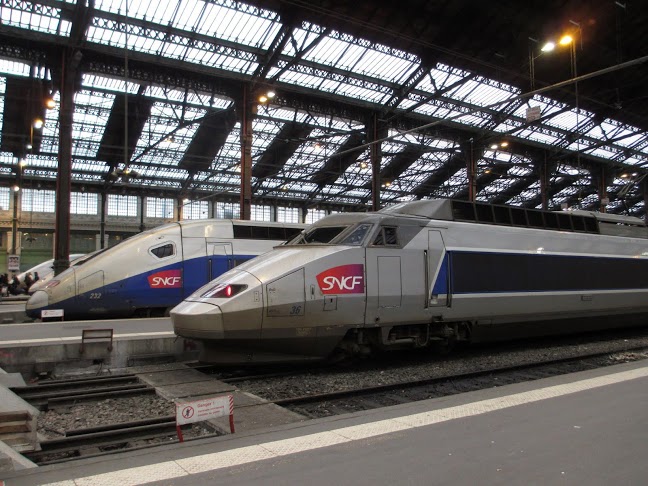The Los Angeles Times and its Disgraceful Reporting on High Speed Rail
1:34 PM PDT on June 18, 2014
On the morning of March 24, I was in the café car on the Eurostar high-speed train, on my way from Paris to London. I glanced out the window as we zoomed at nearly 200 mph past a stopped train, a concrete platform and some parked cars.
I asked the barista if that was Haute-Picardie station. She looked at the clock, gave a Gallic shrug, and said “probablement.” I told her how I’d read in the Los Angeles Times that California’s High Speed Rail project needs a re-design, citing Haute-Picardie as evidence that intermediate stations slow the whole system.
She chortled and said “did we slow down?”
Under the new state budget, $250 million was allocated for California HSR in the next fiscal year. With a portion of cap-and-trade funds now dedicated to the project, it will have a way to move steadily forward. This was covered widely in the press, including in the Times. But more often than not, Times coverage has been alarmingly one-sided, substandard and inaccurate.
For example, on December 15, 2011, the paper ran “Bullet Train’s Travel-Time Mandate Adds to Ballooning of Costs.” It was written by Ralph Vartabedian, the principal reporter on the beat, and Dan Weikel. It says that “In the fine print of a 2008 voter-approved measure funding the project was a little-noticed requirement that trains be able to rocket from Union Station in downtown Los Angeles to San Francisco in no more than two hours and 40 minutes.” The article's premise is that the speed requirements were virtually unknown and that was causing huge complications.
On page one of Proposition 1A, which launched the project, it says, in bullet points: “Establishes a clean, efficient 220 MPH transportation system.” The obligation to complete the journey in two hours and 40 minutes is deeper inside, but it's in the same print as the rest of the law. The speeds were well known. And existing HSR trains go fast enough to fulfill the mandate.
On Nov. 12, 2012, Vartabedian wrote a piece entitled "Bullet-Train Planners Face Huge Engineering Challenge." He wrote that the train will “...cross more than half a dozen earthquake faults heading toward L.A,” as if there’s a big question about whether it’s prudent to run HSR in areas prone to temblors.
I wrote the following letter to the editor in response:
On March 11, 2011, Japan was hit by the largest earthquake in its history. There were 27 bullet trains running through the destruction zone. But early warning computers hit the emergency brakes as soon as the shockwaves were detected. The quake and accompanying tsunami killed 16,000 people and destroyed 129,000 buildings. Yet the bullet trains stayed on the tracks, continuing Japan’s perfect safety record for its half-century old network. It’s odd that Vartabedian focuses on high-speed train engineering and earthquakes without mentioning history's most definitive real-world test.
They emailed me back that the letter was approved and would likely run in a few days.
But it didn’t. Instead, they ran letters that were negative on the project.
The Times will occasionally run a “positive” story. For example, in Dec. of last year they published an Op-Ed entitled “How to Make High-Speed Rail Work in California.” It was written by Stuart Flashman, identified innocently as an “Oakland attorney who has represented governmental and public interest clients on high-speed rail issues since 2004.” It doesn't mention that he’s suing to stop the project on behalf of clients on the ROW in the Central Valley and Bay Area. Not surprisingly, his alignment suggestions--besides being unworkable--avoid their properties.
And on February 13, the paper ran: “Don't Give up on the Bullet Train, California” by Tom Zoellner, an associate professor of English at Chapman University. One of his story’s main points was the thing that made the barista on the Eurostar laugh--that local stations such as Haute-Picardie slow things down. “California's current 11-stop road from Los Angeles to San Francisco map routed through Fresno is too jerky and slow,” he wrote. But Japan’s famous Tokyo to Osaka bullet-train line has 15 intermediate stations. Secondary stations have extra tracks, so express trains blow right past locals, just as my Eurostar did. The fact that some trains will stop at Fresno and other smaller stations has no bearing on the overall speed of the system. But eliminating these stations and changing the alignment, as Zoellner suggests, would invalidate the engineering work and the funding, killing California's project.
For years now, nearly every bit of HSR coverage by the Times has been like the articles cited above. I once admired the newspaper and even freelanced for them. It's not in the self-interest of any journalist to accuse editors and potential employers. But at some point every transportation reporter has to step up and point out the obvious: the Los Angeles Times coverage of HSR is deceitful and shamelessly biased.
Stay in touch
Sign up for our free newsletter
More from Streetsblog Los Angeles
Metro Committee Approves 710 Freeway Plan with Reduced Widening and “No Known Displacements”
Metro's new 710 Freeway plan is definitely multimodal, definitely adds new freeway lanes, and probably won't demolish any homes or businesses
Automated Enforcement Coming Soon to a Bus Lane Near You
Metro is already installing on-bus cameras. Soon comes testing, outreach, then warning tickets. Wilshire/5th/6th and La Brea will be the first bus routes in the bus lane enforcement program.





